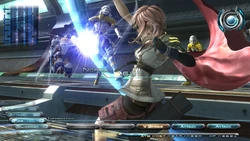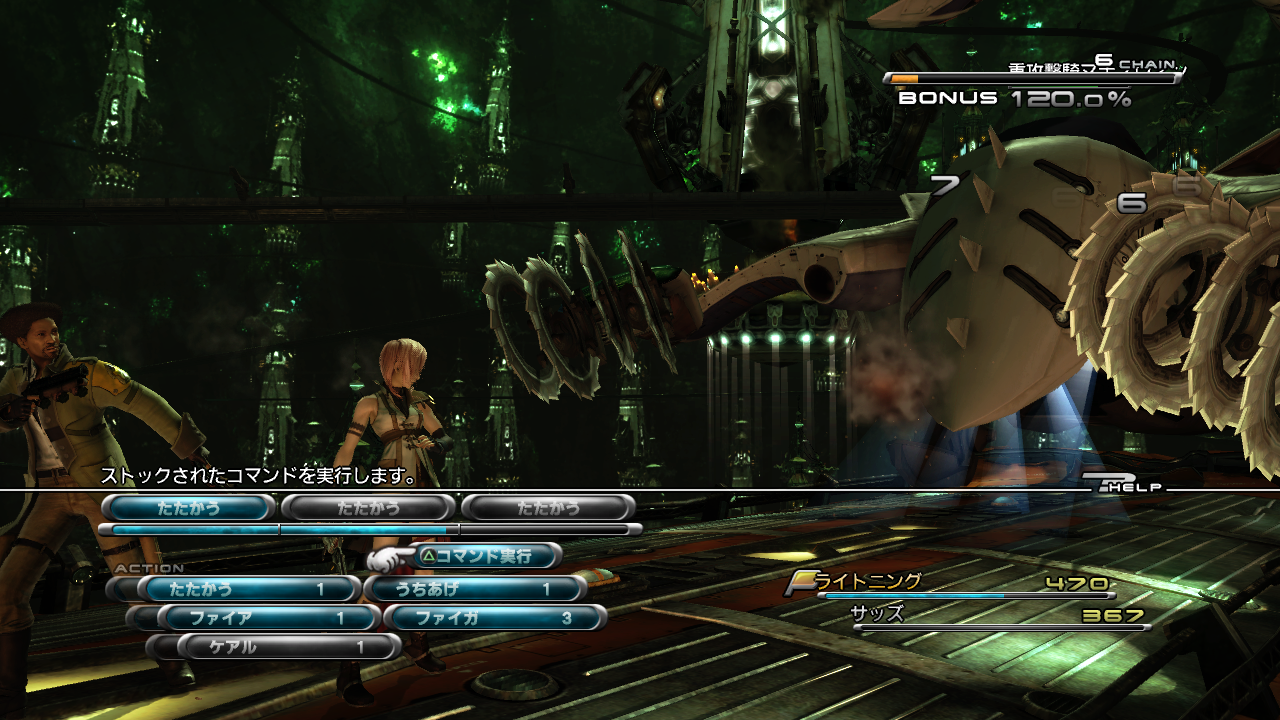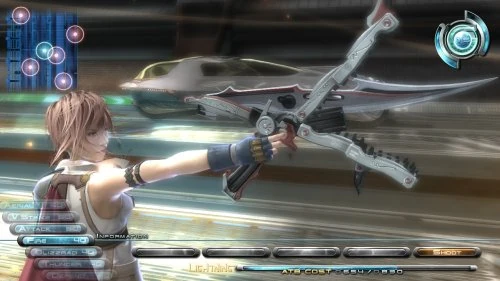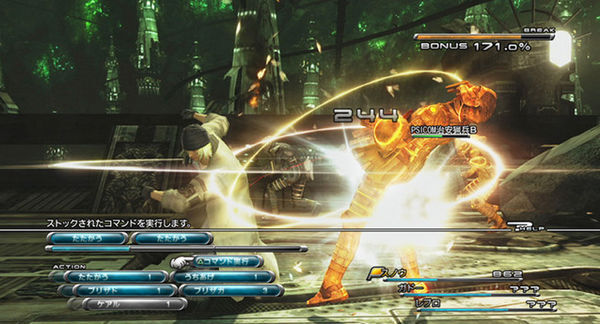
Final Fantasy XIII was revealed to the world at E3 2006 as part of the Fabula Nova Crystallis: Final Fantasy series that it would be the flagship title of. The game was to bring Final Fantasy to the seventh generation of consoles. It had a tricky development cycle, starting as a project for PlayStation 2, and requiring a brand new engine.
The overarching concept of Final Fantasy XIII was "a future world fantasy" and "people fighting against fate".[1] The concept for the battle system was to maintain the strategic nature of command-based battles, but to create battles similar to those seen in the film Final Fantasy VII: Advent Children. The development was led by Yoshinori Kitase and as such, the development team resembled that of Final Fantasy X and Final Fantasy X-2, although occasionally, developers from Final Fantasy XV (then known as Final Fantasy Versus XIII) assisted with the game's development.
From PlayStation 2 to PlayStation 3
In Famitsu, Producer Yoshinori Kitase revealed the initial project concept for Final Fantasy XIII was thought of in 2004 when the Final Fantasy X-2 International team came up with the idea during a jogging session. Final Fantasy XIII was originally planned as a PlayStation 2 game, but the development was moved to PlayStation 3 following May 2005[2] and the team had to restart making the game assets from scratch.
The development of Final Fantasy XIII happened during a time when Square Enix were shifting to a new console generation, and to a certain extent had to anticipate what the future generation would be like. The game was originally developed under the working title "COLORS WORLD".[3] Elements relating to the lore and story that were created for the PlayStation 2 version were kept as-is, but the team re-designed technical elements—such as graphics, battle system, and game mechanics—to specifically match the next-gen console specs.[4]
Final Fantasy XIII only had development on the PlayStation 2 at the very beginning of the project, mainly focused around creating the world and story. The team working on Final Fantasy XIII was derailed when they were commissioned to create the Final Fantasy VII technical demo for PlayStation 3; the demo's results were so promising the development of Final Fantasy XIII was moved to this platform as well.[5] The idea from the start was to have a highly action-based battle system.[6]

Final Fantasy XIII was developed on the Crystal Tools engine since the production moved on PlayStation 3. The process of making the company's first PlayStation 3 title proved to be a challenge as the team found it a tricky console to code for.[6] Determined to crack the puzzle, Square opted to create its own development kit, which became known as Crystal Tools. Building the foundation of the engine alone took several years. During that time, the size of the development team was temporarily reduced, and conducted basic technical research and produced pre-production assets.[4]
During the transition to the PlayStation 3 system, the technical know-how for character model sculpting and texture completely changed from that of the PlayStation 2. As a result, developers and artists were forced to adapt and change, and the team needed to rebuild the workflow and development pipeline from scratch. The project thus moved slowly. Despite launching nearly four years after its announcement in 2006–by which time it had already been in development for roughly two years–director Motomu Toriyama admits the final product was rushed through a short production timeline.[4]
The game is marketed to the public
Final Fantasy XIII was revealed at E3 2006. Since then, the battle system was changed several times. In the first trailer the camera angles and shifts were more dynamic and the main character Lightning had a gravity-controlling ability that influenced the gameplay, lending to a somewhat more action-based and cinematic presentation than the final, more classic battle system. In the playable demo, the battle transitions were nearly seamless as the exploration and battle fields were similar in appearance, unlike in the final game where the differences between the two fields are more apparent.
It was revealed at E3 2008 that Final Fantasy XIII would be released on the Xbox 360 and the PlayStation 3 in North America and Europe, but would remain a PlayStation 3 exclusive in Japan. A demo version of Final Fantasy XIII was released with Final Fantasy VII: Advent Children Complete in Japan on April 16 exclusively for PlayStation 3. Covering a part from the early stages of the game, the demo aimed to familiarize players with the battle system, while featuring Cocoon and the l'Cie. Only Lightning and Snow were playable, with Sazh, Lebreau and Gadot supporting them during battles. The demo was not released outside of Japan.

"Re: Final Fantasy XIII" is a promotional DVD that was released by Square Enix in Japan on December 13th, 2008, to advertise the upcoming games of the Fabula Nova Crystallis: Final Fantasy series. Said to be included were never-before-seen trailers, along with the rarely seen trailers shown at the DKS3137 conventional event. The DVD is reported to be fifty minutes and includes the first look at real Final Fantasy XIII gameplay. Included on the DVD as well were promos for Final Fantasy VII: Advent Children Complete, the original Dissidia Final Fantasy, and movies for non-Final Fantasy Square titles. A second demo was featured in the Final Fantasy XIII Premiere Party and Tokyo Game Show in September 2009, showcasing the summons as well as the Paradigm Shift system. Again, only Lightning and Snow could be controlled in battle, while Sazh, Vanille, and Hope were supporting party members.
The initial screenshots of the Xbox 360 version Square Enix released to compare to the PlayStation 3 version were revealed, in fact, to be screenshots from the PlayStation 3 version, with the Xbox 360 icons pasted on top. Square Enix apologized, claiming it was a mistake, and later released genuine Xbox 360 screenshots. The Xbox 360 version runs at 576p (FMV CG 576p), as opposed to the PlayStation 3's native resolution of 720p (FMV CG 1080p), but both versions can be upscaled to 1080p.
A problematic development
Development of Final Fantasy XIII was a difficult one and ridden with miscommunication between different sections of the development team. Final Fantasy XIII had the largest development team of any previous Final Fantasy game, with some of the work also done in conjunction with the Final Fantasy XV team (then-titled Final Fantasy Versus XIII). At the peak, there were over 200 people working on it, with 180 artists, 30 programmers, and 36 game designers.[7]

According to the October 2010 issue of Game Developer magazine[8], a big problem during the game's development was the lack of unified vision. The game was first announced at 2006, but the E3 trailer was merely a visual concept and the team hadn't created anything playable yet, leading to pressure within the development team on what the battle system should be like. What further complicated the development was that the team was also working on Square Enix's multi-platform engine Crystal Tools. The team made the mistake of trying to accommodate every single project in progress and a considerable amount of time was spent prioritizing all the different requests and the team was not able to determine the final spec requirements. It created a standstill between the engine and game development teams; if the engine's specs couldn't be finalized, neither could the game's.
Being a large-scale project Square Enix wanted to keep details of the game secret, but this led to the international player testing being too late, which further led to scheduling constraints as the team wanted to ensure the game would appeal to Western audiences. The development team was well-aware of criticism toward JRPGs coming from North America and Europe concerning game linearity and command-based battles; the development team experimented with Western development methods and international focus groups were set up for certain titles, including Final Fantasy XIII.
However, at this time the development team was already far along in development and it was too late to implement most of the feedback. Despite this, the team was able to gain some insight into what players wanted globally, but also led to conflicts because the development team didn't receive clear instructions on whether to force certain changes into an already tight schedule. Much of the feedback which was unable to be included in Final Fantasy XIII, was later used when developing Final Fantasy XIII-2.[7]

The game's overall vision did not fully realize until the demo included with Final Fantasy VII: Advent Children Complete, because even at a late stage of development, the team did not agree on the game's key elements. The team had to make adjustments to the schedule to accommodate the demo, but after it was complete, the team finally had a tangible version of the game that could actually be played, which unified the vision and understanding of the game's direction across the entire development team. Before the demo, different elements for the game had been created with no clear plan on how they would be used in the final game. With the demo pulling all the strings together, the team could prioritize to help increase productivity.
The way the development team has come out open with the problems with the development is rather unique, and may reflect the polarized reception the game received after its release. Director Motomu Toriyama has said he lamented that Final Fantasy XIII was mainly criticized for its linear game design, and explained that there were several reasons for it. With a limited amount of development time and resources, the team made the game linear to maximize players' gameplay experience and to provide the same type of gameplay experience to all players. The aim was to offer the most entertaining gameplay experience. This approach provided players with time to familiarize with the battle system and the world, but it led to players feeling like the majority of the game was a tutorial. Toriyama believes this was a big flaw in the game.[4]
Cut content

According to art director Isamu Kamikokuryo, many additional areas that were functioning in an unreleased build, from team NORA's secret base, to Lightning's home and even a zoo, were cut from the game owing to concerns about the game's length and volume. Kamikokuryo additionally remarked that the volume of cut content was enough to make another game. Later, hackers have unveiled various dummied content, such as the location Seventh Ark that appears to have been developed as downloadable content.
Localization
Similar to Final Fantasy X, Final Fantasy XI, and Final Fantasy XII, Final Fantasy XIII has only English and Japanese audio with subtitles localized to local languages.
Final Fantasy XIII was being localized for English as it was being made, but it had no infrastructure to support simultaneous development and localization. There were no content freeze deadlines to ensure the translators were translating with the final context, and cut scenes were still changing after the English voice recording was finished. The entire voice script ended up being re-recorded about four or five times. The translators would have to translate blindly from text, and then see an early render to notice it would not work. When placeholder audio would show up the translators would realize their lines wouldn't match the timing or the emotion that would be on the characters' faces. The translators had scripts from the writers, videos of events, transcripts of the actual Japanese voice data, and the latest game build, but all four would be different and none of them final.
Tom Slattery, who was handling the English localization, and Teruaki Sugawara, the sound engineer, who also subsequently left the company, were both serving as representatives from their respective departments at the monthly meetings between Sound and Localization, and both realized that if that was going to be the way localization was handled on subsequent projects, there needed to be a way of keeping all information synchronized without placing unnecessary burden on the development team, Sound, or Localization. When Final Fantasy XIII-2 would be developed, the developers would use a tool called Moomle to do just that.[9]
Jack Fletcher did voice directing and casting for Final Fantasy XIII; his previous experience in the series includes Final Fantasy X, Final Fantasy X-2, Final Fantasy XII, and Final Fantasy Tactics. Around twenty auditions were held for the important characters and Square Enix would let Fletcher cast the rest on his own by giving him character descriptions on how they wanted the characters to sound.[10] For lead and cameo characters the producers would want to hear at least five to eight different voice samples per character to choose from.
The voice directing team would then pick portions from the game script to send to agencies and get auditions back from them. It has also been mentioned that Square Enix does not want to reuse voice actors too much, so anyone who has played a lead role before is unlikely to get another Final Fantasy lead part soon, and so, even if Ashe's voice actress Kari Wahlgren submitted a good audition, Square would not want to cast her as Lightning.[10] The idea to cast two characters with Australian accents came from the localization team, who requested the voice directing team to look for either Australian or New Zealand sounding voices; the rationale was that the team wanted Fang and Vanille to sound like they were from another world, but more in a sense of having a different melody to their voices, rather than a thick accent.[10]
Employee departures
The problematic development of Final Fantasy XIII led to the departure of several members of the development team, who left Square Enix during development or on the game's release, including:
- Toshiro Tsuchida (battle planning director)
- Takashi Ohkuma (background technical director)
- Masashi Hamauzu (composer), who went freelance
- Nao Ikeda (sub-character designer), who went freelance[11]
References
- ↑ Motomu Toriyama in the Final Fantasy XIII: Original Soundtrack liner notes
- ↑ http://uk.ign.com/articles/2006/11/08/final-fantasy-xiii-update-11
- ↑ http://www.siliconera.com/2013/11/04/final-fantasy-xiii-project-originally-called-colors-world/
- ↑ 4.0 4.1 4.2 4.3 Where Final Fantasy Went Wrong, and How Square Enix is Putting It Right (Accessed: UnknownError: See this for how to archive.) at US Gamer
- ↑ http://uk.gamespot.com/news/e3-06-square-enix-announces-trio-of-final-fantasy-xiii-games-6149412
- ↑ 6.0 6.1 Final Fantasy 25th Anniversary Interview with Motomu Toriyama
- ↑ 7.0 7.1 http://www.gamasutra.com/view/news/173093/Square_Enix_to_avoid_largescale_internal_development_after_Final_Fantasy_XIII-2
- ↑ Exclusive: Behind The Scenes Of Square Enix's Final Fantasy XIII
- ↑ http://www.rpgamer.com/features/insidegaming/tslatteryint.html
- ↑ 10.0 10.1 10.2 Final Fantasy Union Voice Director Interview
- ↑ http://kotaku.com/#!5778294/is-making-final-fantasy-a-nightmare